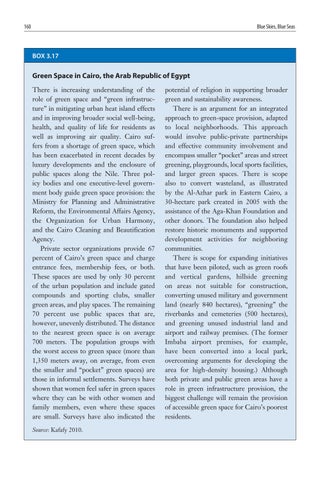160
Blue Skies, Blue Seas
BOX 3.17
Green Space in Cairo, the Arab Republic of Egypt There is increasing understanding of the role of green space and “green infrastructure” in mitigating urban heat island effects and in improving broader social well-being, health, and quality of life for residents as well as improving air quality. Cairo suffers from a shortage of green space, which has been exacerbated in recent decades by luxury developments and the enclosure of public spaces along the Nile. Three policy bodies and one executive-level government body guide green space provision: the Ministry for Planning and Administrative Reform, the Environmental Affairs Agency, the Organization for Urban Harmony, and the Cairo Cleaning and Beautification Agency. Private sector organizations provide 67 percent of Cairo’s green space and charge entrance fees, membership fees, or both. These spaces are used by only 30 percent of the urban population and include gated compounds and sporting clubs, smaller green areas, and play spaces. The remaining 70 percent use public spaces that are, however, unevenly distributed. The distance to the nearest green space is on average 700 meters. The population groups with the worst access to green space (more than 1,350 meters away, on average, from even the smaller and “pocket” green spaces) are those in informal settlements. Surveys have shown that women feel safer in green spaces where they can be with other women and family members, even where these spaces are small. Surveys have also indicated the Source: Kafafy 2010.
potential of religion in supporting broader green and sustainability awareness. There is an argument for an integrated approach to green-space provision, adapted to local neighborhoods. This approach would involve public-private partnerships and effective community involvement and encompass smaller “pocket” areas and street greening, playgrounds, local sports facilities, and larger green spaces. There is scope also to convert wasteland, as illustrated by the Al-Azhar park in Eastern Cairo, a 30-hectare park created in 2005 with the assistance of the Aga-Khan Foundation and other donors. The foundation also helped restore historic monuments and supported development activities for neighboring communities. There is scope for expanding initiatives that have been piloted, such as green roofs and vertical gardens, hillside greening on areas not suitable for construction, converting unused military and government land (nearly 840 hectares), “greening” the riverbanks and cemeteries (500 hectares), and greening unused industrial land and airport and railway premises. (The former Imbaba airport premises, for example, have been converted into a local park, overcoming arguments for developing the area for high-density housing.) Although both private and public green areas have a role in green infrastructure provision, the biggest challenge will remain the provision of accessible green space for Cairo’s poorest residents.






